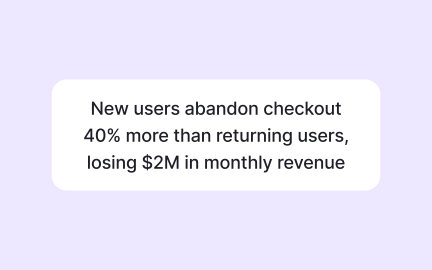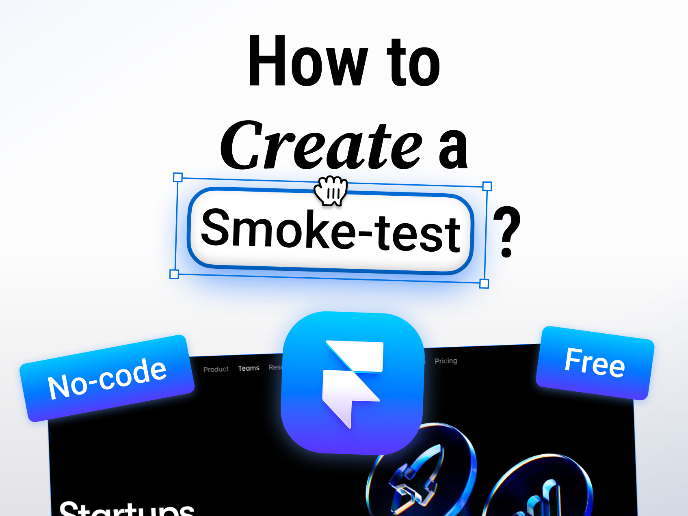Product Discovery
Product discovery is the process of identifying what to build by exploring user needs, validating problems, and testing early product ideas.
What is Product Discovery?
Your product development builds features nobody wants because teams jump straight into delivery without validating assumptions, leading to wasted sprints on perfectly executed solutions to problems customers don't actually have or aren't willing to pay to solve.
Most teams treat discovery as optional research phase before the "real work" of building begins, missing the continuous learning process that separates successful products from feature graveyards filled with unused functionality built on untested assumptions.
Product discovery is the continuous process of identifying, validating, and refining customer problems and potential solutions before committing to building, ensuring development efforts focus on creating genuine value rather than implementing interesting ideas that miss market needs.
Teams practicing effective product discovery reduce feature failure by 70%, accelerate time-to-value by 50%, and achieve significantly better product-market fit because they validate direction before expensive development rather than hoping customers want what seems logical internally.
Think about how Amazon validates ideas through working backwards from press releases, or how successful startups like Airbnb discovered through continuous experimentation that professional photography transformed listing quality and booking rates.
Why Product Discovery Matters for Product Success
Your feature launches disappoint because beautiful execution can't save fundamentally flawed assumptions about what customers need, leading to low adoption rates and frustrated teams who built exactly what was specified but not what creates value.
The cost of skipping discovery compounds through every failed feature and pivoted product. You waste development resources, accumulate technical debt from unused features, damage team morale with unsuccessful launches, and lose market position while competitors who discover better solutions capture your customers.
What effective product discovery delivers:
Better product-market fit and customer satisfaction because discovery validates both problems and solutions with real users rather than building based on internal assumptions and executive opinions.
When teams practice continuous discovery, products evolve based on evidence rather than following roadmaps built on untested hypotheses about customer needs.
Reduced development waste and faster iteration through early validation that kills bad ideas cheaply rather than discovering failure after months of development effort.
Enhanced team confidence and motivation because building validated solutions feels purposeful rather than gambling development effort on unproven concepts.
Stronger competitive advantage through deeper customer understanding as discovery reveals non-obvious insights competitors miss by jumping straight to obvious solutions.
Improved stakeholder alignment and buy-in through evidence-based decisions rather than opinion battles about what customers probably want.
Advanced Product Discovery Strategies
Once you've mastered basic discovery, implement sophisticated validation and learning approaches.
Continuous Discovery Coaching: Embed discovery coaches in teams rather than centralized research, building organizational capability for ongoing learning.
Discovery Operations and Infrastructure: Create platforms for rapid experimentation rather than ad-hoc testing, enabling faster learning cycles through reusable tools.
Quantitative-Qualitative Discovery Integration: Combine behavioral data with user interviews rather than choosing methods, creating complete pictures of user reality.
Opportunity Mapping and Solution Exploration: Use structured frameworks rather than random discovery, ensuring systematic coverage of problem and solution space.
Step 1: Establish Continuous Discovery Habits (Week 1)
Schedule regular customer interactions rather than one-time research projects, building ongoing learning rhythms rather than periodic validation sprints.
This creates discovery foundation based on continuous insight rather than point-in-time understanding that quickly becomes outdated as markets evolve.
Step 2: Separate Problem Discovery from Solution Discovery (Week 1-2)
Explore customer problems deeply before jumping to solutions rather than validating predetermined features, ensuring you solve right problems rather than wrong ones elegantly.
Focus problem discovery on root causes rather than symptoms, using techniques like "5 whys" to understand what really drives customer behavior.
Step 3: Build Rapid Experimentation Capabilities (Week 2-3)
Create systems for testing assumptions quickly and cheaply rather than lengthy research projects, favoring learning velocity over perfect methodology.
Balance experimental rigor with speed to generate insights fast enough to influence decisions rather than confirming what you already built.
Step 4: Synthesize Insights into Actionable Decisions (Week 3-4)
Transform discovery findings into clear product decisions rather than interesting reports, connecting insights to specific changes in strategy or features.
Step 5: Measure Discovery Impact on Outcomes (Month 2+)
Track whether discovery activities improve product success metrics rather than just doing research, demonstrating value through better product decisions and outcomes.
This ensures product discovery drives real improvement rather than academic exercises that don't influence what actually gets built.
If discovery doesn't reduce product failure, examine whether insights actually change decisions rather than confirming existing plans with selective evidence.
The Problem: Discovery that happens too late, validating features already in development rather than informing what should be built.
The Fix: Front-load discovery before roadmap commitments rather than retrofitting validation, ensuring insights drive planning rather than confirming it.
The Problem: Teams that do discovery but don't change course based on findings, treating it as checkbox rather than decision input.
The Fix: Create explicit decision points tied to discovery rather than parallel tracks, forcing teams to act on insights rather than acknowledge and ignore.
The Problem: Discovery paralysis where teams research endlessly without moving to delivery, using learning as excuse to avoid building.
The Fix: Time-box discovery phases with clear decision criteria rather than perfect knowledge, accepting uncertainty while reducing risk to acceptable levels.
Create product discovery approaches that improve success rates rather than adding research theater without influencing actual product decisions.
Recommended resources
Courses

UX Research

HTML Foundations











